तेल ताड़ का पत्ता वेबवॉर्म, एक उभरता हुआ गंभीर कीट और तेल ताड़ के बागानों में इसका प्रबंधन
Oil palm (ElaeisguineensisJacquin: Arecaceae) is known to be the highest edible oil yielding perennial crop, capable of yielding 4-5 MT of palm oil and 0.4-0.5 MT palm kernel oil with good planting material, irrigation and proper management. However, the productivity is not achieved due to infestation by a wide range of fauna which include insects, birds, mites and mammals, apart from diseases, nutrient deficiencies, water stress etc.
As the oil palms grow and attain tallness, the leaves of adjacent palms are overlapped, thereby preventing sunlight penetration in the plantations, a more favourable environment is created for the pests to proliferate and cause severe outbreaks in oil palm.
There are at least 80 species of arthropods are associated with oil palm and many are potential pests and some are serious and inflicting heavy damage on oil palms in India. Recently, a new species, Acriameyricki (Lepidoptera: Depressariidae) (Shashank and Ramamurthy) is described and reported from Andhra Pradesh, India infesting on oil palm for the first time.
The pest is often referred as oil palm leaf webworm, because, the caterpillars spin a protective white silk web sheltering them while eroding the leaflets. It was first noticed during the winter months of 1995-96 in few oil palm plantations in Andhra Pradesh, India.
In order to achieve effective pest management in oil palm, the information regarding life history, seasonal occurrence, nature of damage, favourable ecological factors, effective chemicals etc are very essential. Therefore, the goal of this article is to provide that information to the oil palm growers and to other stakeholders of oil palm.
Life history of oil palm leaf webworm
Meyricki is a small moth with filiform antennae (Fig.1). Forewing is sub-oblong in both the sexes. Forewing of male is pale greyish white, while it is greyish brown in female with fringes at the apex in both the sexes.
Hind wing is whitish with long whitish fringe in male, while it is greyish white with whitish long fringe in female. Female moths are bigger in size than male moths.
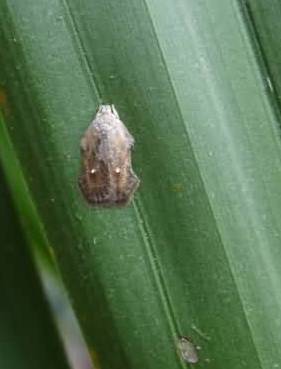
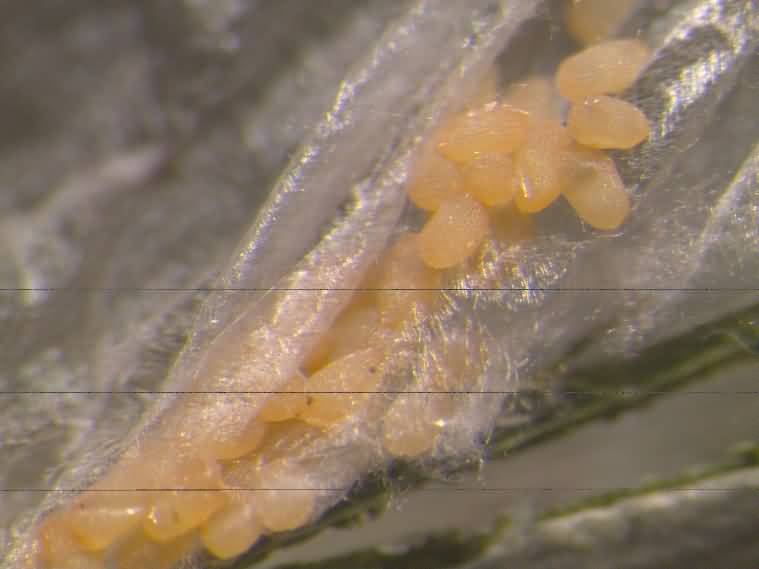
Figure 1 Moth of leaf webworm Figure 2 Eggs of leaf webworm
On an average, a female lays 101.60 eggs in masses. Females start laying eggs one or two days after mating and continue for about 3.60 days. Female moths live longer (6.20 days) than male moths (4.93 days). Gravid female deposits eggs on the old larval silken webs.
The eggs are straw yellow in colour initially and turned to pale orange at the time of hatching, oblong in shape, chorian is sculptured (Fig. 2). Eggs hatches in about 6.38 days. The newly hatched larvae are creamy yellow in colour. Upon hatching, they construct white silken web on leaf lamina and remain inside the web (Fig. 3), scrapping the chlorophyll content and leaving the upper epidermis of leaf intact.
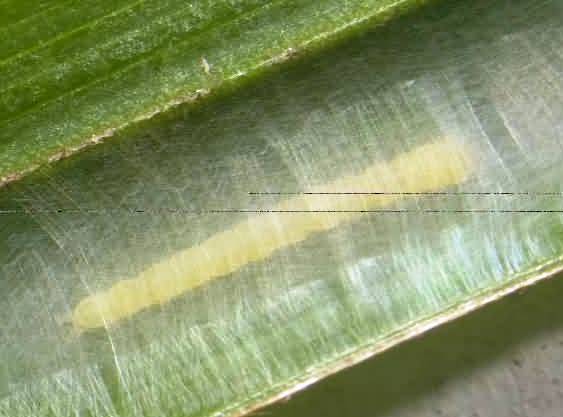
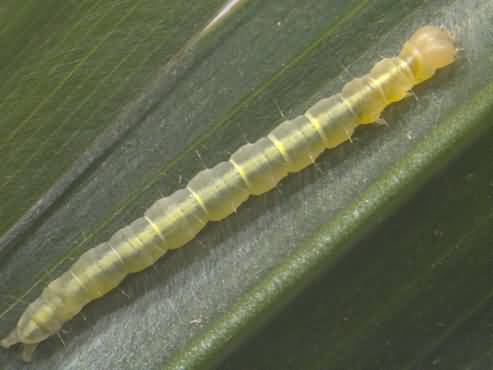
Figure 3 Larva inside the web Figure 4 Larva of leaf webworm
The larvae develop through six to seven instars in 20.13 days. The full grown larvae are translucent yellowish green with pale yellow head and thorax, and a pale yellow mid dorsal stripe on the body (Fig. 4). It attains a maximum body length and width of 14.33 and 1.27 mm respectively.
The full-grown larvae usually leave the old web at the time of pupation and construct a new web, stop feeding, reduce the body length to 11.65 mm and increased the body width to 1.42 mm, remove the last larval skin along with head capsule inside the web.
Pupation takes place within the web and this stage lasts for about 5.38 days. The pupae are pale yellow in colour initially and later turned to light brown in colour (Fig. 5). The length and width of the pupae are 6.81 and 2.58 mm respectively.
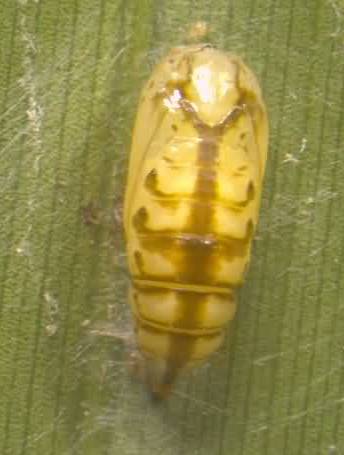 Figure 5 Pupa of leaf webworm
Figure 5 Pupa of leaf webworm
Symptoms and nature of damage
The caterpillars are damaging oil palm of all ages (from nursery to adult palms). Soon after hatching, they initiate the construction of a white silken web on the under surface of the leaf lets. The caterpillars typically live singly in the web throughout their development, feeding by remaining inside.
The larvae have the habit of constructing new web at each eclosion to accommodate their increasing size. Early instar caterpillars (usually 1-3 instars) scrap chlorophyll containing parenchymatous tissues, leaving the upper epidermis intact, which caused parchment like necrotic patches on the leaf lets. Late instar caterpillars (usually 4-7 instars) consume entire leaf tissues causing large, irregular holes along the midribs on the leaf let (Fig. 6).
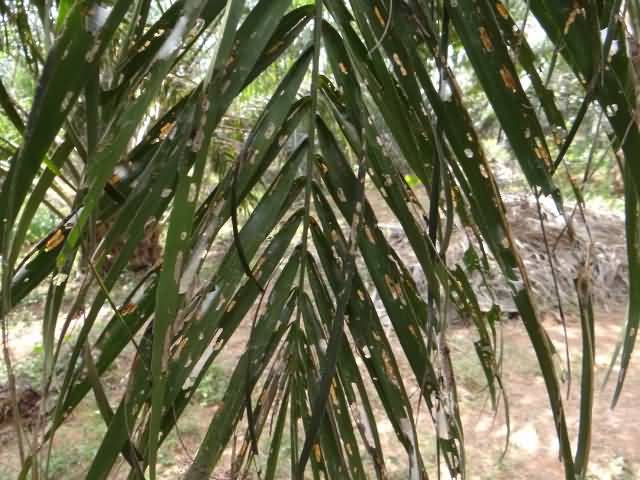
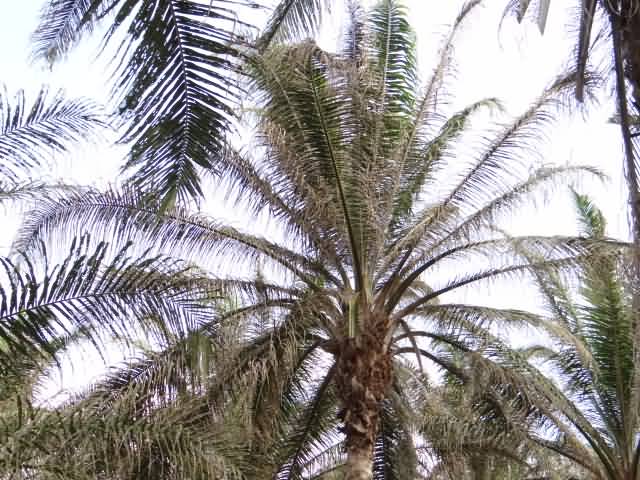
Fig 6&7: Leaflets damaged by the caterpillars and Severely damaged oil palm
Each larva constructed 7-8 webs during its development. Upon disturbance, the caterpillars spin silken threads and will drop from the tree and may float along the breeze and retracted when danger is ceased. Usually, leaf webworm damages the lower and middle leaves in the canopy of the palms.
In severe cases, the whole plantation presents a scorched appearance with large feeding holes along the midribs or usually left with midribs only (Fig.7)
When the palms are severely damaged, the infested fronds droop and it usually takes 2-3 years for the palms to recover completely. This adversely affected the productivity of the palms in the subsequent years.
In coastal Andhra Pradesh, India, defoliation caused by Acriameyricki resulted to the yield losses of 29.0 % in the first year, 31.0 % in the second year and 21.0 % in the consequent year.
Seasonal occurrence
The pest activity in oil palm plantations is coincided with cool weather conditions of the year. Normally, the pest commences its activity in October and continue to be active until early April of the following year with some variations in the time of first appearance and disappearance in the field during different seasons.
Pest activity is normally high during the middle of January, February and March. It is found that as the temperature rises in April, there is a decline of pest activity sharply in coastal Andhra Pradesh, India. If the occurrence is severe, palms are severely denuded by the end of April.
Maximum and minimum temperature prevailing during October, November, December, January, February and March are found conducive for the pest activity. In general terms, the occurrence is erratic and confining to a few gardens in alternate years.
In some gardens it has become a regular pest occurring every year and cause severe damage. Pearson correlation co efficient analysis between larval density and weather factors also confirmed a significant correlation with minimum and maximum temperature.
Management
- The lower fronds having pest stages are to be pruned at the beginning of the pest activity period and burn them in order to reduce the pest multiplication.
- Under field conditions, larvae are found parasitized by two biocontrol agents viz., Apanteleshyposidrae Wilkinson (Hymenoptera: Braconidae) and Elasmusbrevicornis Gahan (Hymenoptera: Eulophidae) to the extent of 21.41 to 36.58 per cent. Whereas, pupaare parasitized by Brachymeriaalbotibialis (Ashmead) (Hymenoptera: Chalcididae) to the tune of 21.21 to 79.75 per cent parasitism. Hence, in order to conserve biological control agents in the gardens, application of chemical pesticides should be considered as last resort.
- Application of the microbial organisms namely Beauveria bassiana, Metarhiziumanisopliae and Lecanicilliumlecaniiare proved to check the pest population, however with delayed action.
- In severe case of infestation, aerial spraying of lambda cyhalothirn@ 0.50 ml/litre, deltamethrin @ 1 ml/litre or chlorantraniprole @1.0 ml/ water orthiodicarb 1.0 ml/litre of water can effectively bring the insect population under control.
- Spraying should be timed to coincide with the maximum occurrence of young larvae, which are more sensitive to insecticides. If the palms attain tallness and not accessible for spraying, stem injection or root feeding may be carried out using systemic insecticides like imidacloprid 17.8 SL @ 10 ml in 100 ml of water/palm.
Author
Dr. L. Saravanan,
Senior Scientist (Agricultural Entomology)
Present address: ICAR-National Bureau of Plant Genetic Resources, Regional Station
Rajendranagar, Hyderabad-500030
Email:
